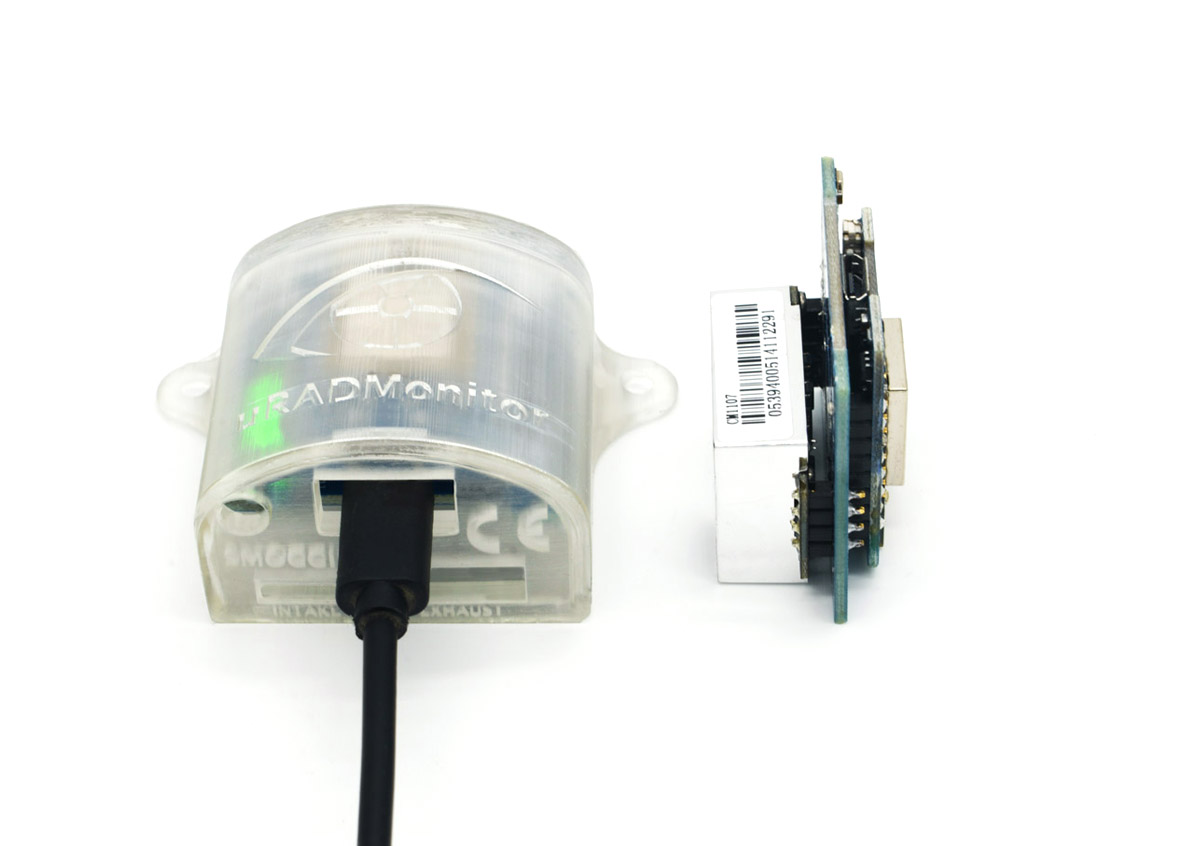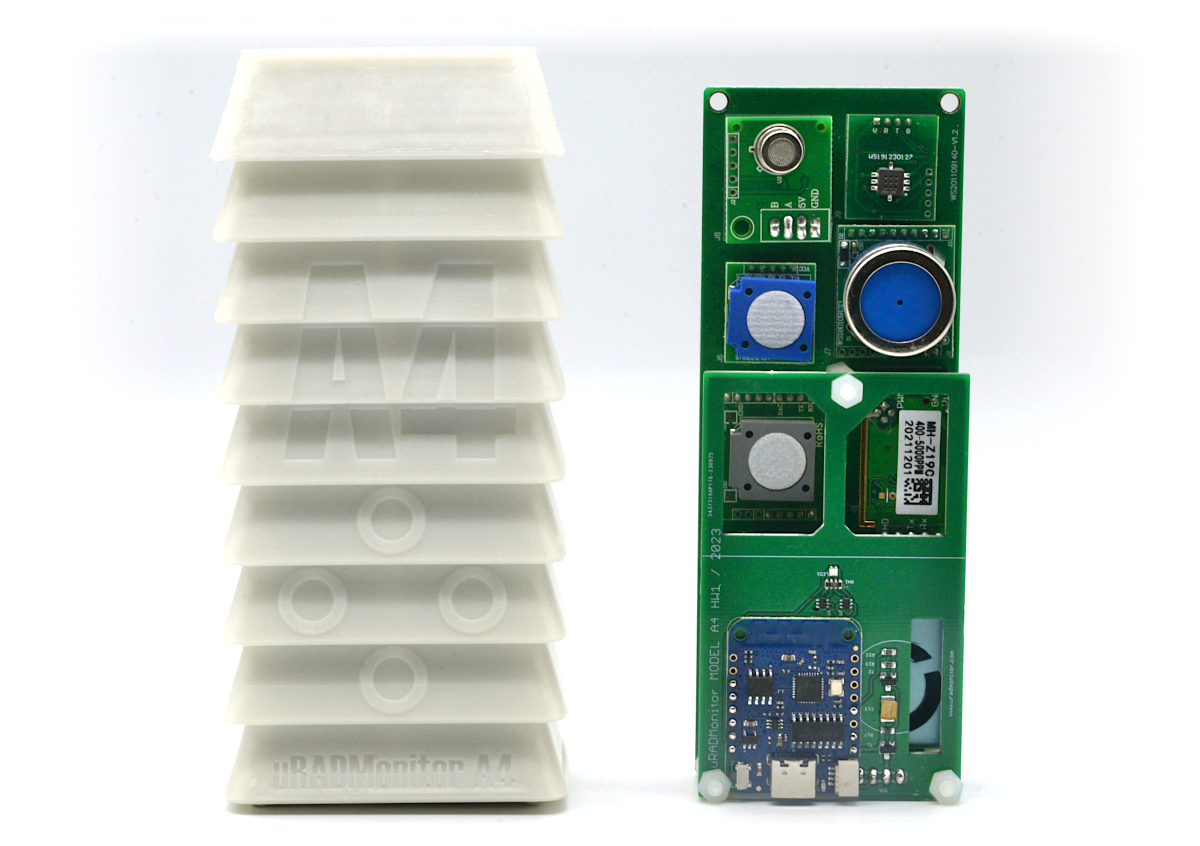MODEL A3Contact us
Plug and play advanced air quality monitoring station, enclosed in an aluminium body for rugged design, it has sensors for Particulate Matter (PM2.5, PM1, PM10), Ozone, Formaldehyde, Carbon Dioxide, Volatile Organic Compounds (VOC), temperature, barometric pressure, air humidity and noise. The A3 comes in 4 variants with connectivity options: Ethernet, Wifi, GSM (with a data sim card) and LoraWAN. This monitor is lab tested for data accuracy.
Manuel, Germany: "Please keep that project going, it is a great idea and all people may benefit from it :)"
uRADMonitor model A3 uses a MEMs sensor to measure air temperature and humidity. A MOX VOC sensor measures volatile organic compounds. A high quality laser scattering sensor is used to detect the Particulate Matter PM2.5 concentration in air. There are two electrochemical sensors, one for formaldehyde sensor and another one for ozone and a nondispersive infrared sensor for CO2. A built in fan assures an active air flow stream across the sensing elements. There is also a noise level sensor.
* VOC concentration interval is estimated for alcohol.
To see complete specs see the technical datasheet.
| Sensor | Parameter | Minimum value | Maximum value |
| MEMs | Temperature | -40 °C | +85 °C |
| Humidity | 0% RH | 100% RH | |
| Laser scattering | PM1.0 | 0 μg/m³ | 1000 μg/m³ |
| PM2.5 | 0 μg/m³ | 1000 μg/m³ | |
| PM10 | 0 μg/m³ | 1000 μg/m³ | |
| Electrochemical | Formaldehyde | 0 ppm | 5 ppm |
| Electrochemical | Ozone | 0 ppm | 10 ppm |
| NDIR | Carbon Dioxide | 400 ppm | 5000 ppm |
| MOX | VOC | 10 ppm | 1000 ppm * |
| Analogue sound sensor | Noise level | 30dB | 130dB |
To see complete specs see the technical datasheet.
Many of the pollutants measured by Model A3 can have a negative impact on our health, ranging from simple allergies to various cancers. Therefore the data gathered by this device is valuable for our understanding on the quality of our
environment.

Picture: uRADMonitor fights pollution to improve our health
VOC or volatile organic compounds are a class of substances that evaporate at room temperature. Being different
substances may be responsible for a broad category of disorders, including respiratory problems, allergic or weakening
immunity in children. Some VOC ‘s are responsible for the formation of smog, irritation of eyes, nose and throat,
headaches and concentration problems. In extreme circumstances, more severe complications can occur, such as
damage to liver, kidney and central nervous system or cancer [1]
Particulate matter PM2.5 refers to small particles with a diameter of up to 2.5 microns. These particles can penetrate deep into the lungs , causing allergies, respiratory and cardiovascular diseases [2]
Formaldehyde is a toxic colorless gas with a pungent smell, that results from the burning of carbon based materials. It can be found in forest fires, in automobile exhaust and cigarette smoke. It is an allergenic and a known carcinogenic compound that can cause serious health effects, depending on concentration and exposure. Even in tiny quantities just above 0.1ppm it can irritate the eyes and nose, and can worsen asthma symptoms [3]
Carbon dioxide is a gas heavier than air. In small quantities of up to 5000ppm (0.5% ) can cause headaches, lethargy, slowing of intellectual ability, irritability, sleep disturbance. In larger quantities can cause dizziness, loss of sight, hearing or knowledge. The fresh air contains between 360ppm and 410 ppm of CO2 [4]
Ozone can cause the muscles in the airways to constrict, trapping air in the alveoli. This leads to wheezing and shortness of breath. Long-term exposure to ozone is linked to aggravation of asthma, and is likely to be one of many causes of asthma development. Long-term exposures to higher concentrations of ozone may also be linked to permanent lung damage, such as abnormal lung development in children. [5]
Noise Induced Hearing Loss (NIHL) is the most common and often discussed health effect, but research has shown that exposure to constant or high levels of noise can cause countless adverse health affects. [6]
[1] Volatile Organic Compounds’ Impact on Indoor Air Quality, US Environmental Protection Agency
[2] Health and Environmental Effects of Particulate Matter (PM), US Environmental Protection Agency
[3] ToxFAQs™ for Formaldehyde, Agency for Toxic Substances and Disease Registry
[4] Effects of low-level inhalation exposure to carbon dioxide in indoor environments
[5] Health Effects of Ozone Pollution, US Environmental Protection Agency
[6] Noise Pollution, US Environmental Protection Agency

Particulate matter PM2.5 refers to small particles with a diameter of up to 2.5 microns. These particles can penetrate deep into the lungs , causing allergies, respiratory and cardiovascular diseases [2]
Formaldehyde is a toxic colorless gas with a pungent smell, that results from the burning of carbon based materials. It can be found in forest fires, in automobile exhaust and cigarette smoke. It is an allergenic and a known carcinogenic compound that can cause serious health effects, depending on concentration and exposure. Even in tiny quantities just above 0.1ppm it can irritate the eyes and nose, and can worsen asthma symptoms [3]
Carbon dioxide is a gas heavier than air. In small quantities of up to 5000ppm (0.5% ) can cause headaches, lethargy, slowing of intellectual ability, irritability, sleep disturbance. In larger quantities can cause dizziness, loss of sight, hearing or knowledge. The fresh air contains between 360ppm and 410 ppm of CO2 [4]
Ozone can cause the muscles in the airways to constrict, trapping air in the alveoli. This leads to wheezing and shortness of breath. Long-term exposure to ozone is linked to aggravation of asthma, and is likely to be one of many causes of asthma development. Long-term exposures to higher concentrations of ozone may also be linked to permanent lung damage, such as abnormal lung development in children. [5]
Noise Induced Hearing Loss (NIHL) is the most common and often discussed health effect, but research has shown that exposure to constant or high levels of noise can cause countless adverse health affects. [6]
[1] Volatile Organic Compounds’ Impact on Indoor Air Quality, US Environmental Protection Agency
[2] Health and Environmental Effects of Particulate Matter (PM), US Environmental Protection Agency
[3] ToxFAQs™ for Formaldehyde, Agency for Toxic Substances and Disease Registry
[4] Effects of low-level inhalation exposure to carbon dioxide in indoor environments
[5] Health Effects of Ozone Pollution, US Environmental Protection Agency
[6] Noise Pollution, US Environmental Protection Agency
The model A3 is designed as an automated, fixed, Air Quality monitoring station. The A3 is IOT and it comes in 4 variants, with the same sensors but offering different connectivity options: Ethernet, Wifi, GSM/GPRS and LoraWAN. It takes any voltage in the 6V - 28V interval and uses less than 1 Watt of power to run. A built in speaker can provide audible notifications, configurable via the dashboard. This unit doesn't have a screen, it works as a monitor and the data can be viewed remotely on a computer or on a mobile device.
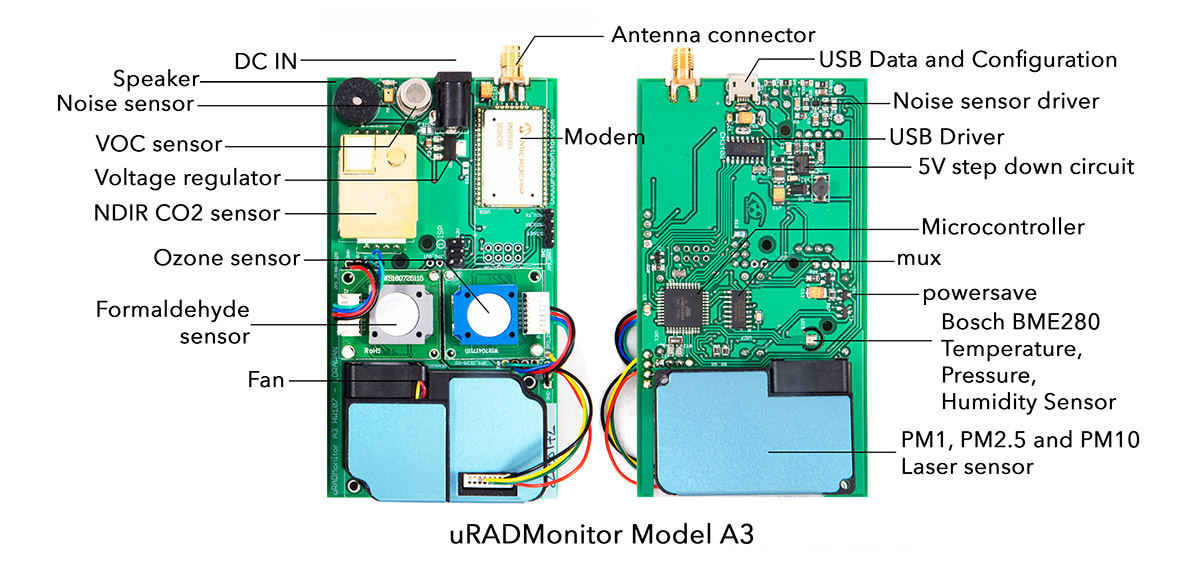
Picture: uRADMonitor A3 motherboard front and bottom view

| Item | Parameter | Ratings |
| Voltage | External | 6V - 28V |
| Connectivity | 4 options | Ethernet, WiFi, GSM, LoRaWAN |
| Microcontroller | Atmega1284p | 8 bit |
| Enclosure | Rugged aluminium | 110x80x24 mm |
Your uRADMonitor unit can be mounted both indoors and outdoors, but not directly exposed to sun, to avoid overheating in warmer areas. A covered spot with some shadow if installed in the free air, is ideal. The unit has a rugged aluminium enclosure that is not rainproof due to the air vents. Make sure that nothing is blocking the air vents. The enclosure has wall-mounting brackets, making installation easy.
If you have a radio variant with an antenna, connect the antenna first. If it is the wired variant, connect it to the Internet Router using the Ethernet cable. Connect the uRADMonitor to the power source using a DC adapter with voltage between 6V and 28V or via the USB port with a 5V USB adapter.
The Ethernet variant
Make sure the device is connected to the Internet router using the Ethernet cable. Use a longer cable if needed. The Internet router must have DHCP enabled. When powered, the uRADMonitor gets an IP automatically, via DHCP, and will show up on the map automatically.
The WIFI variant
Use a smartphone or a computer with WLAN capabilities to connect to the local hotspot spawned by your A3 unit. The SSID is uRADMonitor-XX, where XX are the last two digits of the Device ID number. The key is the Device ID, in uppercase, as printed on the enclosure. Open 192.168.4.1 in your browser, and click the "WIFI" link to setup the connection to the Internet AP. Enter the SSID and key of your Internet Access Point. If the connection fails, you will see the status message, and three consecutive beeps will indicated the problem. Alternatively you can change the configuration using the USB data port. See the USB manual.
The LORAWAN variant
Your device must be pre-provisioned with the LoraWAN Gateway and network server details. Alternativelly you can change the configuration using the USB data port. See the USB manual.
The GSM variant
A data SIM card must be inserted in your A3 unit before it can connect over Internet.
Starting with hardware version HW106, the LoRaWAN, Wifi and GSM settings can be customized via the USB connection. Consult your product manual for complete details.
If you have a radio variant with an antenna, connect the antenna first. If it is the wired variant, connect it to the Internet Router using the Ethernet cable. Connect the uRADMonitor to the power source using a DC adapter with voltage between 6V and 28V or via the USB port with a 5V USB adapter.
The Ethernet variant
Make sure the device is connected to the Internet router using the Ethernet cable. Use a longer cable if needed. The Internet router must have DHCP enabled. When powered, the uRADMonitor gets an IP automatically, via DHCP, and will show up on the map automatically.
The WIFI variant
Use a smartphone or a computer with WLAN capabilities to connect to the local hotspot spawned by your A3 unit. The SSID is uRADMonitor-XX, where XX are the last two digits of the Device ID number. The key is the Device ID, in uppercase, as printed on the enclosure. Open 192.168.4.1 in your browser, and click the "WIFI" link to setup the connection to the Internet AP. Enter the SSID and key of your Internet Access Point. If the connection fails, you will see the status message, and three consecutive beeps will indicated the problem. Alternatively you can change the configuration using the USB data port. See the USB manual.
The LORAWAN variant
Your device must be pre-provisioned with the LoraWAN Gateway and network server details. Alternativelly you can change the configuration using the USB data port. See the USB manual.
The GSM variant
A data SIM card must be inserted in your A3 unit before it can connect over Internet.
Starting with hardware version HW106, the LoRaWAN, Wifi and GSM settings can be customized via the USB connection. Consult your product manual for complete details.
Quick Start
Product Manual
Technical Datasheet
USB Serial Commands Manual
LoRaWAN Data Server Callback manual
Product Limited Warranty terms
uRADMonitor with WIFI Configuration manual
Data access:
Terms of Service
API Terms of Service
API and Server Specs
Direct Data access
Payload Structure (FW78)
Accuracy lab tests and certifications
INCD ECOIND Report (ISO 17025 compliant), for testing the A3 against the reference methods
AQMD AQ-SPEC Performance test report
USB Driver
In their recent versions, Windows, Linux and MacOS come with built in drivers for your uRADMonitor unit. Use the following resources only if the built in drivers do not work for you.
USB Driver for Windows
USB Driver for Linux
USB Driver for MacOS
RO:
RO: Ghid rapid de utilizare
Fisa tehnica
Product Manual
Technical Datasheet
USB Serial Commands Manual
LoRaWAN Data Server Callback manual
Product Limited Warranty terms
uRADMonitor with WIFI Configuration manual
Data access:
Terms of Service
API Terms of Service
API and Server Specs
Direct Data access
Payload Structure (FW78)
Accuracy lab tests and certifications
INCD ECOIND Report (ISO 17025 compliant), for testing the A3 against the reference methods
AQMD AQ-SPEC Performance test report
USB Driver
In their recent versions, Windows, Linux and MacOS come with built in drivers for your uRADMonitor unit. Use the following resources only if the built in drivers do not work for you.
USB Driver for Windows
USB Driver for Linux
USB Driver for MacOS
RO:
RO: Ghid rapid de utilizare
Fisa tehnica
SMOGGIE-CO2Contact us
This is a compact, automated Carbon Dioxide monitor. It detects CO2 levels in your home via a high quality non dispersive infrared sensor. Carbon dioxide at levels that are unusually high indoors may cause occupants to grow drowsy, to get headaches, or to function at lower activity levels. There is an additional sensor for temperature and humidity. It connects to the internet via Wifi and can be powered by a standard 5V micro-usb cable. It provides real time 24/7 CO2 monitoring that can help you improve your indoor air quality.
Swaleh, Mauritius: "You have a good vision for the wellness of mankind, your effort will pay and mankind will benefit."
SMOGGIE-CO2 is an automated, fixed, CO2 monitoring device. It has Wifi connectivity to report the air quality measurements in real time. Runs on 5V, powered by a standard micro-USB cable. It shows indications via coloured RGB LED and the data history can be viewed remotely on a computer or on a mobile device.
To see complete specs see the technical datasheet.
| Sensor | Parameter | Minimum value | Maximum value |
| MEMs | Temperature | -40 °C | +85 °C |
| Humidity | 0% RH | 100% RH | |
| NDIR CO2 Sensor | CO2 | 400 ppm | 5000 ppm |
Carbon dioxide is a gas heavier than air. In small quantities of up to 5000ppm (0.5% ) can cause headaches, lethargy,
slowing of intellectual ability, irritability, sleep disturbance. In larger quantities can cause dizziness, loss of sight, hearing
or knowledge. The fresh air contains between 360ppm and 410 ppm of CO2 [1]
Carbon Dioxide is a contributing factor to the Sick building syndrome (SBS), a medical condition where people in a building suffer from symptoms of illness or feel unwell for no apparent reason. The symptoms tend to increase in severity with the time people spend in the building, and improve over time or even disappear when people are away from the building. The main identifying observation is an increased incidence of complaints of symptoms such as headache, eye, nose, and throat irritation, fatigue, and dizziness and nausea. These symptoms appear to be linked to time spent in a building, though no specific illness or cause can be identified. A 1984 World Health Organization (WHO) report suggested up to 30% of new and remodeled buildings worldwide may be subject of complaints related to poor indoor air quality.
In homes and offices:
A 100 ppm increase in indoor CO2 concentration was significantly associated with headache (..). Office workers exposed to indoor CO2 concentrations higher than 800 ppm reported a significant increase in eye irritation and upper respiratory symptoms . A 100 ppm increase in dCO2 in the range from 467 to 2800 ppm in indoor CO2 was significantly associated with dry throat, tiredness, and dizziness (417 participants from 87 offices) (Lu et al., 2015). A 100 ppm increase in CO2 concentration (range, 549–1318 ppm) was positively correlated with non-specific symptoms including headache and dizziness (107 participants from 11 offices) although the correlation was not significant (Azuma et al., 2018).
Twenty-two participants were exposed to CO2 at 600, 1000, and 2500 ppm (three 2.5-h sessions, one day; artificially elevated CO2 concentrations) in an office-like chamber. Statistically significant decrements occurred in cognitive performance (decision making, problem resolution) starting at 1000 ppm (Satish et al., 2012).

Picture: SMOGGIE-CO2 monitors your home to improve your health
In schools:
A study in schoolchildren exposed to indoor CO2 concentrations higher than 1000 ppm showed significantly higher risk for dry cough and rhinitis (654 children of 46 classrooms) but outdoor air flow rate per person was inversely correlated with indoor CO2 concentrations (Simoni et al., 2010). A 200 ppm increase in indoor CO2 concentration (range, 1000–2000 ppm) in 45 day care centers (DCCs) was significantly associated with reported wheezing in the 3186 attending children, and a positive trend was observed between CO2 concentration and the prevalence of asthma.
[1] Effects of low-level inhalation exposure to carbon dioxide in indoor environments
Carbon Dioxide is a contributing factor to the Sick building syndrome (SBS), a medical condition where people in a building suffer from symptoms of illness or feel unwell for no apparent reason. The symptoms tend to increase in severity with the time people spend in the building, and improve over time or even disappear when people are away from the building. The main identifying observation is an increased incidence of complaints of symptoms such as headache, eye, nose, and throat irritation, fatigue, and dizziness and nausea. These symptoms appear to be linked to time spent in a building, though no specific illness or cause can be identified. A 1984 World Health Organization (WHO) report suggested up to 30% of new and remodeled buildings worldwide may be subject of complaints related to poor indoor air quality.
In homes and offices:
A 100 ppm increase in indoor CO2 concentration was significantly associated with headache (..). Office workers exposed to indoor CO2 concentrations higher than 800 ppm reported a significant increase in eye irritation and upper respiratory symptoms . A 100 ppm increase in dCO2 in the range from 467 to 2800 ppm in indoor CO2 was significantly associated with dry throat, tiredness, and dizziness (417 participants from 87 offices) (Lu et al., 2015). A 100 ppm increase in CO2 concentration (range, 549–1318 ppm) was positively correlated with non-specific symptoms including headache and dizziness (107 participants from 11 offices) although the correlation was not significant (Azuma et al., 2018).
Twenty-two participants were exposed to CO2 at 600, 1000, and 2500 ppm (three 2.5-h sessions, one day; artificially elevated CO2 concentrations) in an office-like chamber. Statistically significant decrements occurred in cognitive performance (decision making, problem resolution) starting at 1000 ppm (Satish et al., 2012).

In schools:
A study in schoolchildren exposed to indoor CO2 concentrations higher than 1000 ppm showed significantly higher risk for dry cough and rhinitis (654 children of 46 classrooms) but outdoor air flow rate per person was inversely correlated with indoor CO2 concentrations (Simoni et al., 2010). A 200 ppm increase in indoor CO2 concentration (range, 1000–2000 ppm) in 45 day care centers (DCCs) was significantly associated with reported wheezing in the 3186 attending children, and a positive trend was observed between CO2 concentration and the prevalence of asthma.
[1] Effects of low-level inhalation exposure to carbon dioxide in indoor environments
SMOGGIE-CO2 is designed as an automated, fixed, Air Quality monitoring station that measures and reports the Carbon Dioxide concentration automatically, 24/7. It comes with built-in Wifi connectivity and it only needs 5V to run, supplied via a standard micro-USB cable. It will monitor your location 24/7 to inform you on elevated CO2 levels that can impact your health.
The units can be managed via the dashboard. The data can be viewed remotely on a computer or on a mobile device.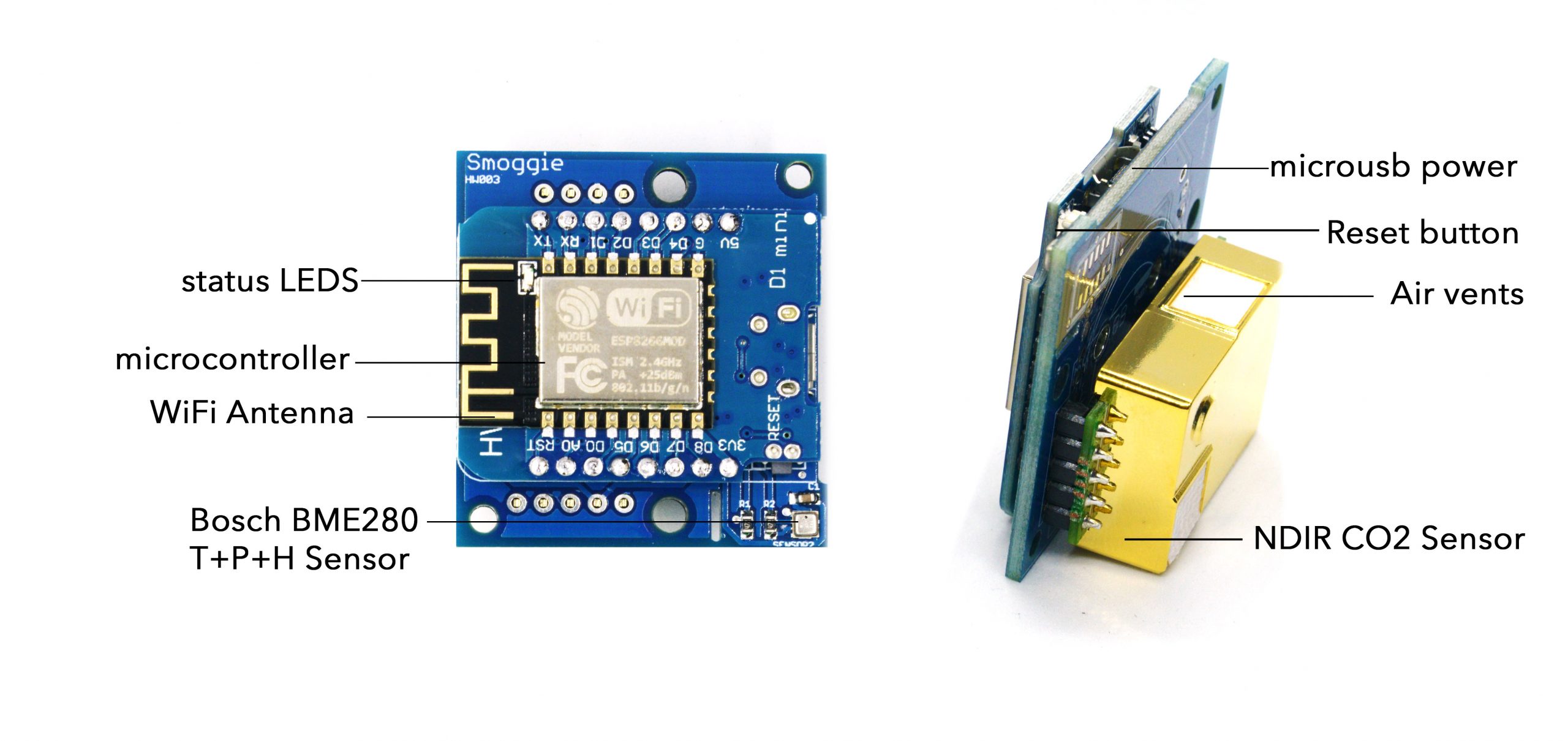
Picture: uRADMonitor SMOGGIE motherboard and enclosure
The units can be managed via the dashboard. The data can be viewed remotely on a computer or on a mobile device.

| Item | Parameter | Ratings |
| Voltage | External | 5V micro-USB |
| Consumption | Current | 80mA (max 170mA on CO2 pulse) |
| Connectivity | Internet | Wifi |
| Microcontroller | ESP8266 | 8 bit |
| Enclosure | Rainproof plastic | 42x43x27 mm |
Your uRADMonitor unit can be mounted both indoors and outdoors where the enclosure offers protection against sun, rain or snow. The unit has a plastic enclosure with two holes and can be easily attached to a wall with only two screws. The sensor opening must face down for open air access. Make sure that nothing is blocking the air vents. The openings and the internal heating of the electronics are aligned to generate an active airflow.
Quick Setup
Connect it to power using a 5V micro-USB cable. Use a smartphone or a computer with WLAN capabilities to connect to the local hotspot spawned by your SMOGGIE unit. The SSID is uRADMonitor-XX, where XX are the last two digits of the Device ID number. The first time, the key is the Device ID, in uppercase, as printed on the enclosure. You can change this key later. Open 192.168.4.1 in your browser, and click the "WIFI/CONFIG" link to setup the connection to the Internet AP. Select the SSID and enter the key of your Internet Access Point.
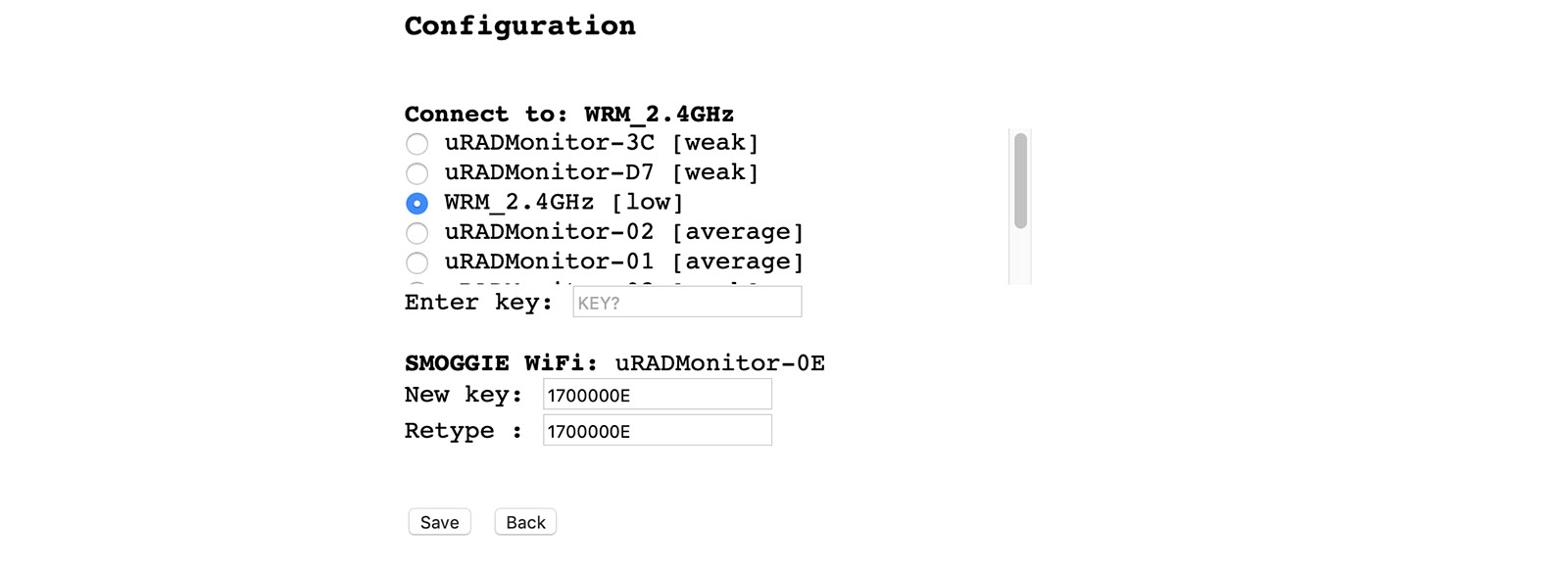
Picture: SMOGGIE Config Page
If the connection fails, you will see the status message.
USB configuration
Alternatively, the SSID and KEY can also be configured via USB. Connect to your SMOGGIE via USB, baudrate 9600bps, open a terminal program and type the two commands: "key1","SSID" then "key2","your WLAN key" . Use the "getsettings" command to verify that the new settings are in place. Quotes are a must, and there are no spaces in between. See the USB Commands manual for more. See the USB Commands manual if you need more help.
Quick Setup
Connect it to power using a 5V micro-USB cable. Use a smartphone or a computer with WLAN capabilities to connect to the local hotspot spawned by your SMOGGIE unit. The SSID is uRADMonitor-XX, where XX are the last two digits of the Device ID number. The first time, the key is the Device ID, in uppercase, as printed on the enclosure. You can change this key later. Open 192.168.4.1 in your browser, and click the "WIFI/CONFIG" link to setup the connection to the Internet AP. Select the SSID and enter the key of your Internet Access Point.

USB configuration
Alternatively, the SSID and KEY can also be configured via USB. Connect to your SMOGGIE via USB, baudrate 9600bps, open a terminal program and type the two commands: "key1","SSID" then "key2","your WLAN key" . Use the "getsettings" command to verify that the new settings are in place. Quotes are a must, and there are no spaces in between. See the USB Commands manual for more. See the USB Commands manual if you need more help.
Quick Start
Technical Datasheet
USB Serial Commands Manual
Product Limited Warranty terms
uRADMonitor with WIFI Configuration manual
Open source on Github
Data access:
Terms of Service
API Terms of Service
API and Server Specs
Direct Data access
USB Driver
In their recent versions, Windows, Linux and MacOS come with built in drivers for your uRADMonitor unit. Use the following resources only if the built in drivers do not work for you.
USB Driver for Windows
USB Driver for Linux
USB Driver for MacOS
RO:
Fisa tehnica
RO: Ghid rapid de utilizare
RO: conditii generale de utilizare
Technical Datasheet
USB Serial Commands Manual
Product Limited Warranty terms
uRADMonitor with WIFI Configuration manual
Open source on Github
Data access:
Terms of Service
API Terms of Service
API and Server Specs
Direct Data access
USB Driver
In their recent versions, Windows, Linux and MacOS come with built in drivers for your uRADMonitor unit. Use the following resources only if the built in drivers do not work for you.
USB Driver for Windows
USB Driver for Linux
USB Driver for MacOS
RO:
Fisa tehnica
RO: Ghid rapid de utilizare
RO: conditii generale de utilizare
MODEL A4Contact us
Multiparameter advanced air quality monitoring station, in a rainproof enclosure for both outdoor and indoor use. Contains 8 individual sensors to track Temperature, Relative Humidity, Nitrogen Dioxide, Formaldehyde, Carbon Monoxide, Ozone, Carbon Dioxide, Particulate Matter PM1, PM2.5, PM10 and Volatile Organic Compounds (VOC). Modular design that saves costs. Stevenson shield included, ready for outdoor use!
Urs, Switzerland: "My second A3 has just been delivered - perfect service!"
uRADMonitor model A4 uses a MEMs sensor to measure air temperature and humidity. A MOX VOC sensor measures volatile organic compounds. Another MEMs sensor measures Nitrogen Dioxide (NO2) .
A high quality laser scattering sensor is used to detect the Particulate Matter PM1 / PM2.5 and PM10 mass concentration in air. There are three electrochemical sensors, one for formaldehyde (CH2O), another one for Ozone (O3) and one for Carbon Monoxide (CO). A nondispersive infrared sensor for CO2.
Everything is encapsulated under a high quality Stevenson Shield ready for outdoor use.
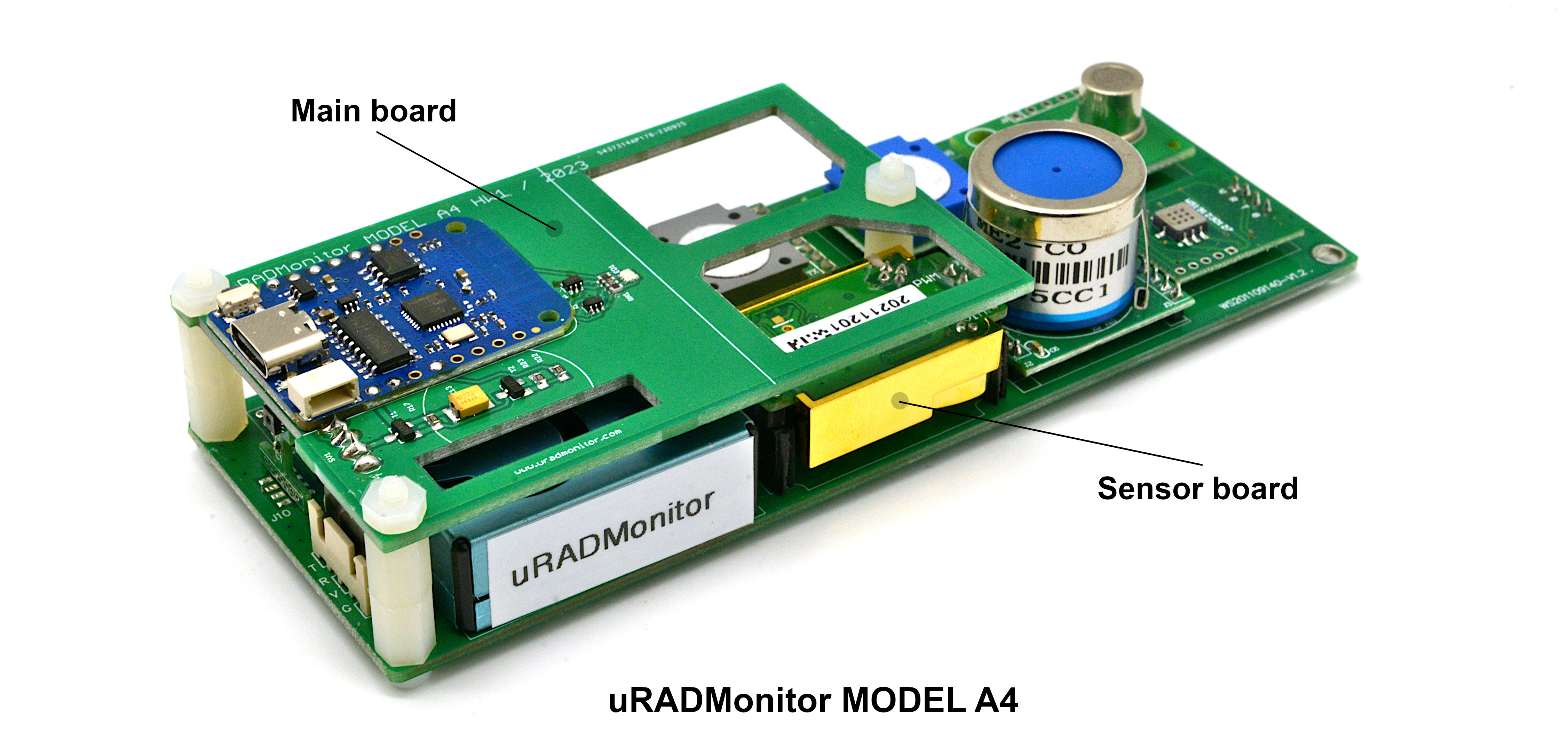
Picture: uRADMonitor A4 has a modular design with sensors on a separate board that can be replaced all together easily
* VOC concentration is provided as a simple score 0 - 3 to reflect air quality
Model A4 is a cost effective multiparameter automated monitor containing 8 high quality digital sensors that track a total of 11 air parameters. It has the capacity to fully characterize the ambient air in regards to health impact based on the major widespread pollutants.

| Sensor | Parameter | Minimum value | Maximum value |
| MEMs | Temperature | -20 °C | +65 °C |
| Humidity | 0% RH | 100% RH | |
| Laser scattering | PM1.0 | 0 μg/m³ | 1000 μg/m³ |
| PM2.5 | 0 μg/m³ | 1000 μg/m³ | |
| PM10 | 0 μg/m³ | 1000 μg/m³ | |
| MEMs | Nitrogen Dioxide | 0 ppm | 10 ppm |
| Electrochemical | Formaldehyde | 0 ppm | 5 ppm |
| Electrochemical | Ozone | 0 ppm | 10 ppm |
| Electrochemical | Carbon Monoxide | 0 ppm | 500 ppm |
| NDIR | Carbon Dioxide | 400 ppm | 5000 ppm |
| MOX | VOC | 0 | 3 * |
Model A4 is a cost effective multiparameter automated monitor containing 8 high quality digital sensors that track a total of 11 air parameters. It has the capacity to fully characterize the ambient air in regards to health impact based on the major widespread pollutants.
Your uRADMonitor unit can be mounted both indoors and outdoors. Its enclosure offers protection to the elements, including sun, rain and snow. A covered spot with some shadow if installed in the free air, is ideal. The stevenson shield enclosure has large air vents, make sure that nothing is blocking them and air can circulate freely. The enclosure has pole / wall-mounting brackets, making installation easy.
Connect the uRADMonitor to the power source using the USB-C cable and the provided USB 5V Adaper.
uRADMonitor Model A4 Works via WIFI
Use a smartphone or a computer with WLAN capabilities to connect to the local hotspot spawned by your A4 unit. The SSID is uRADMonitor-XX, where XX are the last two digits of the Device ID number. The key is the "uradmonitor", in lowercase and without the quotes. You can change this default password later on. Open 192.168.4.1 in your browser, and click the "CONFIG" link to setup the connection to the Internet AP. Enter the SSID and key of your Internet Access Point. If the connection fails, you will see the status message, and three consecutive beeps will indicated the problem. Alternatively you can change the configuration using the USB data port. See the USB manual.
Remember, the Wifi settings can be customized via the USB connection. Consult your product manual for complete details.
Connect the uRADMonitor to the power source using the USB-C cable and the provided USB 5V Adaper.
uRADMonitor Model A4 Works via WIFI
Use a smartphone or a computer with WLAN capabilities to connect to the local hotspot spawned by your A4 unit. The SSID is uRADMonitor-XX, where XX are the last two digits of the Device ID number. The key is the "uradmonitor", in lowercase and without the quotes. You can change this default password later on. Open 192.168.4.1 in your browser, and click the "CONFIG" link to setup the connection to the Internet AP. Enter the SSID and key of your Internet Access Point. If the connection fails, you will see the status message, and three consecutive beeps will indicated the problem. Alternatively you can change the configuration using the USB data port. See the USB manual.
Remember, the Wifi settings can be customized via the USB connection. Consult your product manual for complete details.
Quick Start
Technical Datasheet
USB Serial Commands Manual
LoRaWAN Data Server Callback manual
Product Limited Warranty terms
uRADMonitor with WIFI Configuration manual
Data access:
Terms of Service
API Terms of Service
API and Server Specs
Direct Data access
USB Driver
In their recent versions, Windows, Linux and MacOS come with built in drivers for your uRADMonitor unit. Use the following resources only if the built in drivers do not work for you.
USB Driver for Windows
USB Driver for Linux
USB Driver for MacOS
RO:
RO: Ghid rapid de utilizare
Technical Datasheet
USB Serial Commands Manual
LoRaWAN Data Server Callback manual
Product Limited Warranty terms
uRADMonitor with WIFI Configuration manual
Data access:
Terms of Service
API Terms of Service
API and Server Specs
Direct Data access
USB Driver
In their recent versions, Windows, Linux and MacOS come with built in drivers for your uRADMonitor unit. Use the following resources only if the built in drivers do not work for you.
USB Driver for Windows
USB Driver for Linux
USB Driver for MacOS
RO:
RO: Ghid rapid de utilizare
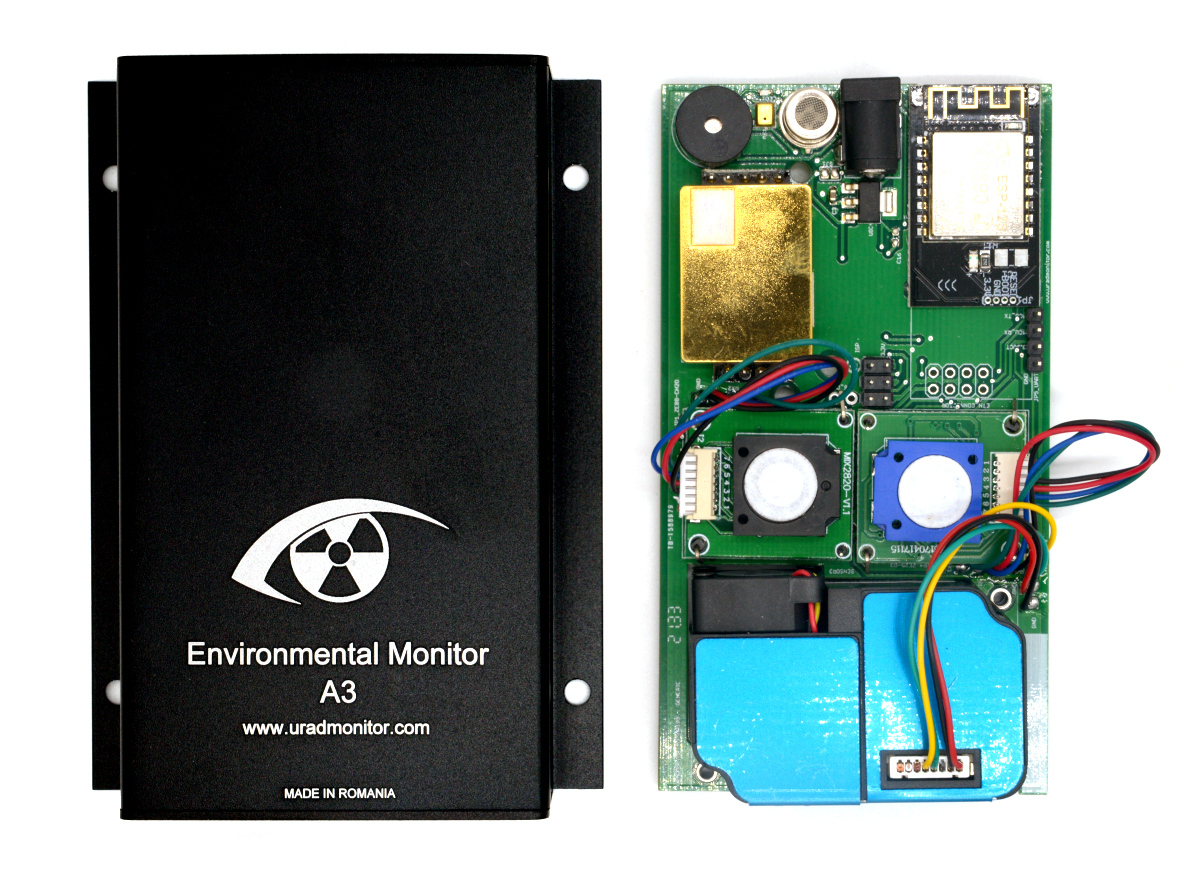
 Available, limited stock.
Available, limited stock.